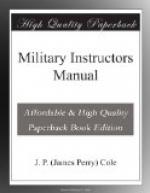Marches and Convoys:
Successful march.—That
which places troops at destination on time,
and in best possible condition.
Rates of March:
Infantry.—2 to 2-1/2
miles per hour.
Cavalry.—4 miles (walk),
8 miles (trot), 12 miles (gallop).
Artillery.—(Same.)
Average Marches:
Infantry.—15-20 miles
per day.
Cavalry.—25 miles per
day.
Artillery.—15-20 miles
per day.
Load of pack mules equals 250 pounds.
March Orders, State:
(1) Object of march.
(2) Distribution of troops.
(3) Order of march of main body.
(4) Manner of forming the column.
Halts:
First hour, 15 minutes’ rest.
Each successive hour, a 10-minute
rest.
Weather conditions create exceptions
to above rule.
Marches in Peace:
(1) Changing station.
(2) Practice.
In War:
(1) Concentration.
(2) In presence of enemy.
(3) Forced marches.
(4) Night marches.
Convoys (on Land):
Those trains by which supplies are
forwarded to an army from depots,
etc., in the rear—also trains bringing
supplies collected by
requisition.
Security Furnished by an Escort:
(1) Advance guard.
(2) Main body.
(3) Flank guard when necessary.
(4) Rear guard.
Favorable places for attacking convoys:
Through woods defile.
Over hedges.
Sharp bends.
Ascending or descending slopes.
Farming corral, watering.
Whenever conditions are such that
escort cannot quickly prepare for
defense.
Conducting Prisoners:
10 foot soldiers to every 100 prisoners.
Infantry:
The principal arm, charged with
the main field work. Its role is
the role of the entire force and its success is the
success of the
whole force.
Artillery:
The close supporting arm of the
infantry.
Its targets are those most dangerous
in the eyes of the infantry.
Cavalry:
Reconnaissance—supports
the other arms and is valuable in pursuit.
Combat:
Offensive.
Defensive.
(a) Temporary.
(b) Passive defense.
Combat Principles:
Fire superiority.
Unity of command.
Simple and direct plans and methods.
All troops necessary to mission
must be assigned at beginning.
Detachments justifiable only when
they can contribute directly to
success of main battle.
Some reserves must be kept.
Flank protection and reconnaissance.
Fire Superiority:
Must be gained early and maintained.
Frontage of Units:
Depth in formation for combat rather
than extension of line.
Reserves:
Fresh troops must be on hand to
(1) Give fire line impetus. (2) To penetrate enemy lines. (3) To fill gaps and help reorganization. (4) To meet counter attacks.
Plan of Action:
Mission of army is to win battle.
Offensive action must be the rule.
When enemy is near every available
means must be taken to gain
information, in order to prepare for deployment.




